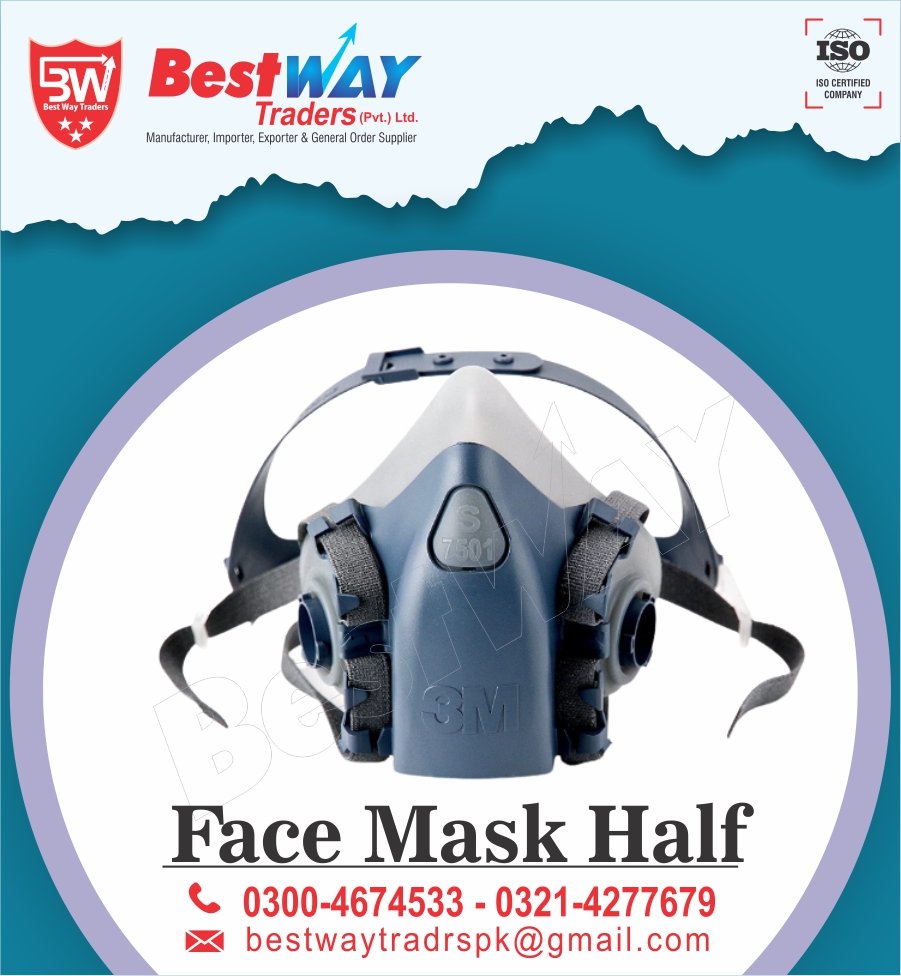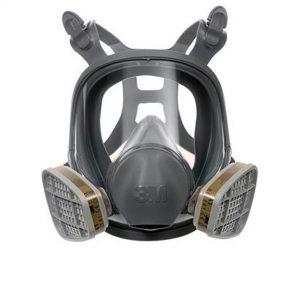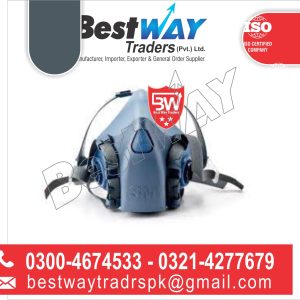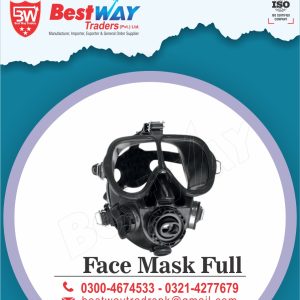Description
FACE MASK HALF DESCREIPTION
The disposable facepiece or the half-mask respirator fits over the nose but does not cover the whole face. A full face mask respirator does cover the whole face; the wartime ‘gas mask’ is of this type. A powered respirator has a fan to assist the flow of air through the filter.
Each type of respirator is available in three performance classifications. Thus, half-mask and full face mask respirators may be of the PI, P2, or P3 specification.
The filters available for respirators are of three types: (1) filters for particular gases and vapors only, (2) filters for dusts and other particulate materials, and (3) combination filters for particular gases and vapors and for dusts and other particulates.
As already stated, the air-purifying respirator differs fundamentally from the air-supplied RPE in that it is not itself a source of air and is therefore of little use unless breathable air can be drawn through it from the surrounding atmosphere. It will not sustain breathing in an asphyxiating atmosphere.
The concentration of oxygen in normal air is approximately 21%. A person breathing air with an oxygen concentration of less than about 16% may manage to do light work for a few minutes, but is likely to exhibit symptoms ranging from labored breathing to unconsciousness or death.
Respirators are produced for military, fire fighting, and industrial uses. In the former case, they are commonly referred to as ‘gas masks.’ A respirator intended for one type of application should not be used for another.
The purifying element may work in several ways. Usually it adsorbs the gas. Alternatively, it may act as a catalyst: carbon monoxide is oxidized catalytically to carbon dioxide.
The element is designed to protect against a particular chemical or group of chemicals and should not be used for other substances. There are a number of toxic gases for which a respirator is quite unsuitable. Respirators should not generally be used against gases which have a high odor threshold or no odor at all, since odor is the only warning of failure of the respirator.
Some toxic gases are irritant to the face and for these full face protection should be used.
It is essential that respirators be kept in good condition and not held too long in stock; otherwise, the air-purifying element and/or the facepiece may deteriorate. The purifying element should be replaced after use or after the elapse of a certain time according to a specified policy.
It will be apparent that, although respirators are the most convenient form of RPE and have many legitimate applications, they also have some serious drawbacks and the circumstances in which they are used should be carefully considered.
Richard P. Pohanish, in Sittig’s Handbook of Toxic and Hazardous Chemicals and Carcinogens (Seventh Edition), 2017
Respirator Selection: Up to 5 milligram per cubic meter: Any air-purifying half-mask respirator with organic vapor cartridge(s) in combination with an N95, R95, or P95 filter. The following filters may also be used: N99, R99, P99, N100, R100, P100; or Sa (APF=10) (any supplied-air respirator). Up to 12.5 milligram per cubic meter: Sa:Cf* (APF=25) (any supplied-air respirator operated in a continuous-flow mode); or PaprOvHie (APF=25) (any powered air-purifying respirator with an organic vapor cartridge in combination with a high-efficiency particulate filter).* Up to 25 milligram per cubic meter: CcrFOv100 (APF=50) [any air-purifying full facepiece respirator equipped with organic vapor cartridge(s) in combination with an N100, R100, or P100 filter]; or GmFOv100 (APF=50) [any air-purifying, full facepiece respirator (gas mask) with a chin-style, front-or back-mounted organic vapor canister having an N100, R100, or P100 filter]; or PaprTOvHie* (APF=50) [any powered, air-purifying respirator with a tight-fitting facepiece and organic vapor cartridge(s) in combination with a high-efficiency particulate filter]; or SCBAF (APF=50) (any SCBA with a full facepiece); or SaF (APF=50) (any supplied-air respirator with a full facepiece). Up to 50 milligram per cubic meter: SCBAF: Pd,Pp (APF=10,000) (any SCBA that has a full facepiece and is operated in a pressure-demand or other positive-pressure mode). Emergency or planned entry into unknown concentrations or IDLH conditions: SCBAF: Pd,Pp (APF=10,000) any SCBA that has a full facepiece and is operated in a pressure-demand or other positive-pressure mode; or SaF: Pd,Pp: ASCBA (APF=10,000) (any supplied-air respirator that has a full facepiece and is operated in a pressure-demand or other positive-pressure mode in combination with an auxiliary self-contained positive-pressure breathing apparatus). Escape: GmFOv100 (APF=50) [any air-purifying, full facepiece respirator (gas mask) with a chin-style, front-or back-mounted organic vapor canister having an N100, R100, or P100 filter]; or SCBAE (any appropriate escape-type, SCBA). *Substance reported to cause eye irritation or damage; may require eye protection.
Respirator Selection
SCBA > 1.8 mg/m3 NIOSH: 1 mg/m3: Any air-purifying half-mask respirator with organic vapor cartridge(s) in combination with an N95, R95, or P95 filter. The following filters may also be used: N99, R99, P99, N100, R100, P100; or Sa (APF = 10) (any supplied-air respirator); 2 mg/m3: Sa:Cf (APF = 25) (any supplied-air respirator operated in a continuous-flow mode); PaprOvHie (APF = 25) (any air-purifying full facepiece respirator equipped with an organic vapor cartridge in combination with a high-efficiency particulate filter); or CcrFOv100 (APF = 50) [any air-purifying full facepiece respirator equipped with organic vapor cartridge(s) in combination with an N100, R100, or P100 filter]; or GmFOv100 (APF = 50) [any air-purifying, full facepiece respirator (gas mask) with a chin-style, front- or back-mounted organic vapor canister having an N100, R100, or P100 filter]; or SCBAF (APF = 50) (any self-contained breathing apparatus with full facepiece); or SaF (APF = 50) (any supplied-air respirator with a full facepiece). Emergency or planned entry into unknown concentrations or IDLH conditions: SCBAF: Pd,Pp (APF = 10,000) (any self-contained breathing apparatus that has a full facepiece and is operated in a pressure-demand or other positive-pressure mode); or SaF: Pd,Pp: ASCBA (APF = 10,000) (any supplied-air respirator that has a full facepiece and is operated in a pressure-demand or other positive-pressure mode in combination with an auxiliary self-contained breathing apparatus operated in a pressure-demand or other positive-pressure mode). Escape: GmFOv100 (APF = 50) [any air-purifying, full facepiece respirator (gas mask) with a chin-style, front- or back-mounted organic vapor canister having an N100, R100, or P100 filter]; or SCBAE (any appropriate escape-type, self-contained breathing apparatus).






Reviews
There are no reviews yet.